Tibetan cuisine offers a unique blend of hearty flavors and cultural richness. Influenced by the Himalayan landscape and Buddhist traditions, Tibetan dishes feature staple ingredients like barley, yak meat, and dairy products. Tsampa, roasted barley flour, forms the basis of many meals, while momos, delicate dumplings filled with meat or vegetables, showcase culinary craftsmanship. Tibetan butter tea, a blend of tea, yak butter, and salt, is a warming staple. Embrace the essence of Tibetan culture through their wholesome and nourishing culinary traditions, which reflect a deep connection to the land and a reverence for simple, hearty ingredients.
Momo
-1707318770.jpg)
Momos, a beloved culinary delight originating from Tibetan and Nepali cuisines, have gained popularity in Bhutan and India as well. These steamed dumplings, typically crafted from a simple white-flour-and-water dough, boast a delectable filling traditionally comprising ground/minced meat, potatoes, and leeks.
One distinguishing feature of momos lies in their accompaniment, a flavorful sauce known as achar, influenced by the aromatic spices and herbs prevalent in South Asian cuisines. Beyond the classic preparation, momos exhibit culinary versatility, with variations like jhol momo, a soup version featuring achar-based broth, and mokthuk, where pork/buffalo bone broth is infused with assorted herbs and vegetables. The dough, sometimes enhanced with yeast or baking soda for a doughy texture, encapsulates a spectrum of fillings. While meat remains a staple, modern iterations incorporate diverse combinations such as tofu, vegetables, soft chhurpi, paneer cheese, mushrooms, and inventive blends of both vegetables and meats.
This evolution mirrors the adaptability of Tibetan cuisine, blending tradition with contemporary tastes, ensuring momos continue to captivate palates worldwide with their harmonious medley of textures and flavors.
Century Egg
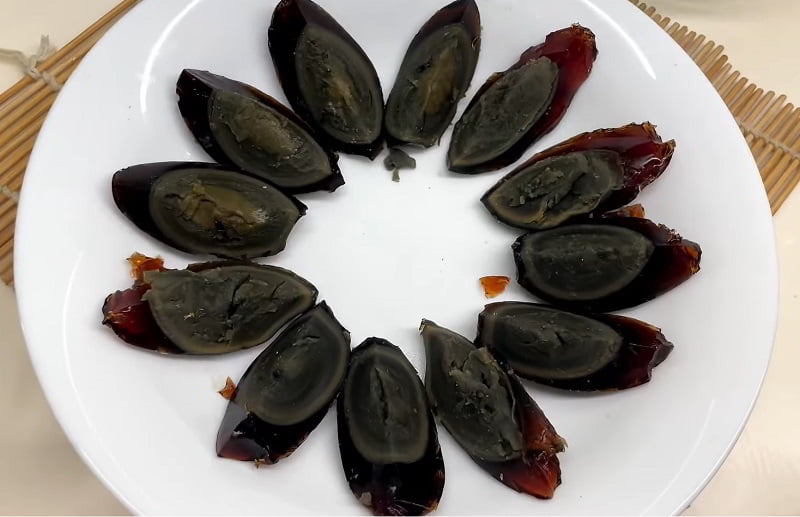
Embraced in Tibetan culinary traditions, the Century Egg, or Alkalized Egg, is a unique Chinese delicacy. Duck, chicken, or quail eggs undergo preservation in a mixture of clay, salt, ash, rice hulls and quicklime for varying durations. This process results in a dark green to grey yolk, exhibiting a creamy texture and intense flavor, courtesy of hydrogen sulfide and ammonia. In parallel, the egg white undergoes a transformation into a dark brown, translucent jelly with a pronounced salty taste. This captivating metamorphosis reflects the meticulous artistry and nuanced flavors characteristic of the Century Egg, a culinary journey celebrated for its distinct appearance and bold taste in both Chinese and Tibetan gastronomy.
Thukpa
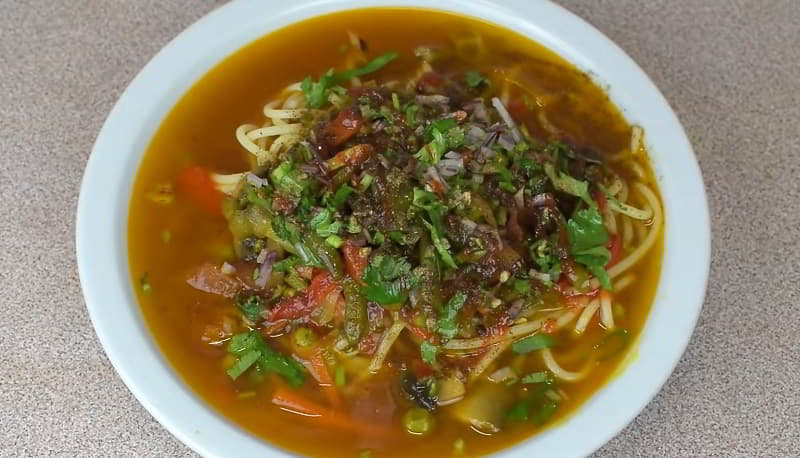
Originating in eastern Tibet, Thukpa stands as a traditional Tibetan noodle soup. Particularly renowned is the Amdo thukpa, with thenthuk being a variant relished by Tibetans, Ladakhis, Nepalese, and the Sikkimese. This noodle soup, embraced across diverse cultures, offers both vegetarian and non-vegetarian renditions, with the chicken variation gaining significant popularity. Thukpa, considered a generic Tibetan term, encapsulates any soup or stew paired with noodles. Its versatility allows for a myriad of preparations, catering to diverse tastes and culinary preferences.
Whether enjoyed in the snowy landscapes of Tibet or savored in the Himalayan regions, Thukpa remains a comforting and nourishing dish, embodying the rich culinary heritage of the Tibetan people. This beloved noodle soup has transcended its cultural origins, finding its place on tables across India and neighboring regions, a testament to its widespread appeal and adaptability.
Butter Tea (Po Cha)
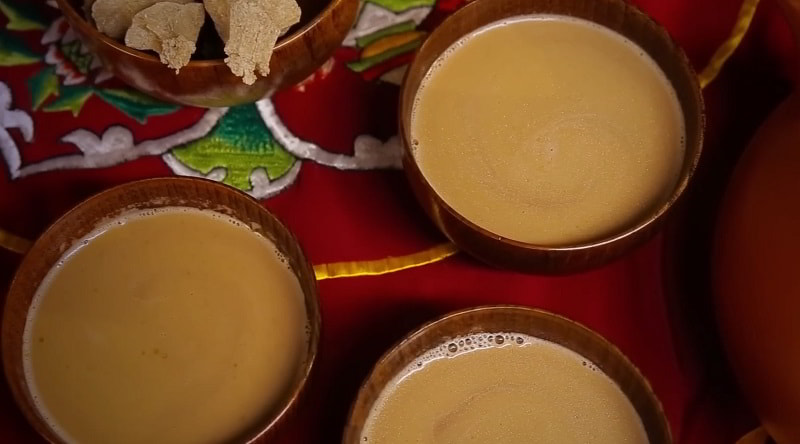
Butter tea, also known as po cha, is a traditional Tibetan drink that holds a significant place in Tibetan cuisine and culture. It is made by steeping fermented tea leaves in hot water for several hours, which creates a strong and bitter base. The tea is then combined with yak butter and salt, resulting in a rich, creamy, and savory beverage. The process of making butter tea is meticulous, as it involves churning the tea vigorously to create a frothy consistency. It is often enjoyed as a staple drink, especially in the cold and high-altitude regions of Tibet, where it helps to keep the body warm and energized.
Butter tea is not just a drink but a symbol of hospitality and friendship in Tibetan culture. It is served to guests as a gesture of warmth and welcome. The high levels of fat and calories in the drink also make it a vital source of nourishment for the Tibetans, who often have to endure harsh weather conditions and strenuous physical activities. Although butter tea might seem unconventional to some palates, it is an integral part of Tibetan cuisine and plays a significant role in the daily lives of the Tibetan people.
Tsampa
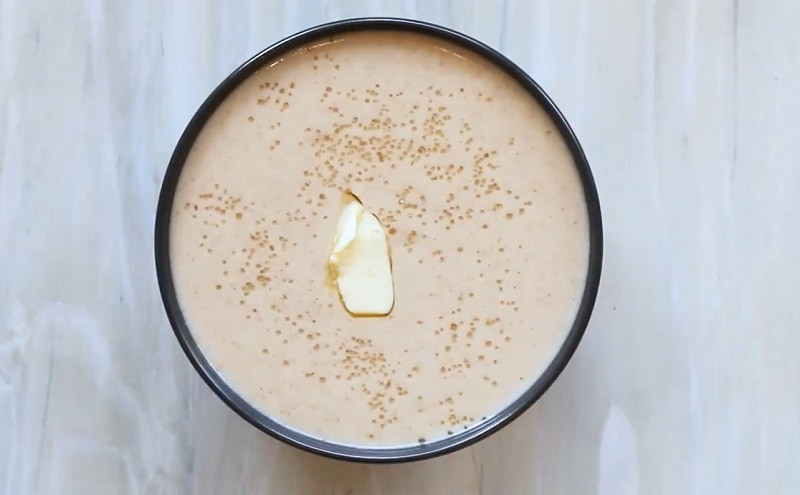
Tsampa, a culinary cornerstone in Tibetan cuisine, carries profound cultural significance within the Tibetan community. Crafted from roasted barley flour, a staple in the Tibetan diet, Tsampa is a versatile and symbolic dish. Barley grains undergo roasting and grinding, resulting in a fine powder, which is then combined with butter tea or water to create a dough-like consistency.
Enjoyed by hand, Tsampa is often shaped into small balls or patties. Its adaptability shines as it can be consumed plain or enhanced with ingredients like butter, sugar, and dried fruits to elevate its flavors. Beyond its culinary appeal, Tsampa holds symbolic value, regarded as a source of strength and nourishment in Tibetan culture. It plays a prominent role in religious ceremonies and festivals, embodying tradition and heritage.
Notably, Tsampa is embraced by Tibetan nomads for its high energy content and extended shelf life, making it an essential companion during their journeys. As a testament to its simplicity, nutritional value, and cultural significance, Tsampa stands as more than just a dish; it is a cherished expression of Tibetan identity and heritage.
Laping
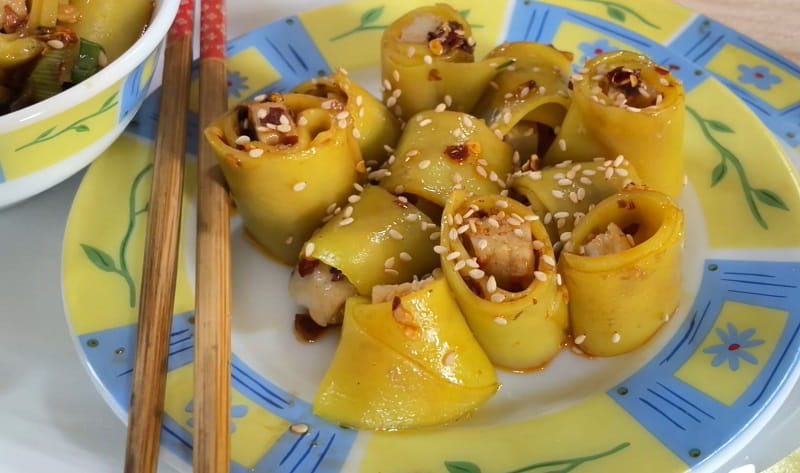
Laping, a chilly cold noodle dish hailing from Tibetan cuisine, has found its way into the streets and hearts of Nepal. Embraced as a popular street food, these plain flour noodles are paired with a lively blend of red pepper chili, coriander, and green onion sauce, offering a unique and satisfying culinary experience. Characterized by their slippery texture, the noodles are served alongside a soy sauce gravy, creating a refreshing summer delight.
Crafted with the aid of a specialized tool for shaping, Laping draws inspiration from the Sichuan-style liangfen, particularly the liangpi variety. Beyond its role as a street-side favorite, Laping exemplifies the interplay of regional influences, highlighting how adaptations contribute to the diverse culinary tapestry of Tibet and Nepal. With its vibrant flavors and cool presentation, Laping has become a cherished dish, capturing the essence of street food indulgence and cultural intermingling.
Chhaang
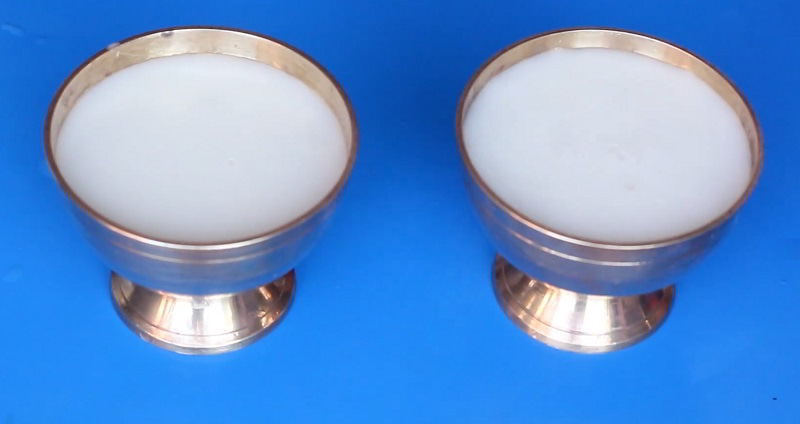
Chhaang or chhyang, a traditional alcoholic beverage, is embraced by diverse communities such as Nepalese and Tibetan, along with various ethnic groups in the eastern Himalayas like Limbu, Yakkha, Newar, Dura, Sunuwar, Rai, Magar, Sherpa, Gurung, Tamang, and Lepcha. In Lepcha culture, it is known as Chi, while in Nepal, it is referred to as jaarh.
Typically consumed at room temperature during summer, Chhaang transforms into a piping-hot libation served in brass bowls or wooden mugs during colder weather. The Limbu people of eastern Nepal have their variation, Tongba. As a kin to beer, Chhaang is brewed using barley, millet (finger-millet), or rice grains. Semi-fermented millet seeds are presented, stuffed in a bamboo barrel called a dhungro. This distinctive beverage, deeply rooted in regional traditions, mirrors the cultural diversity of the Himalayan communities, offering a warm or refreshing libation depending on the season.
Thenthuk
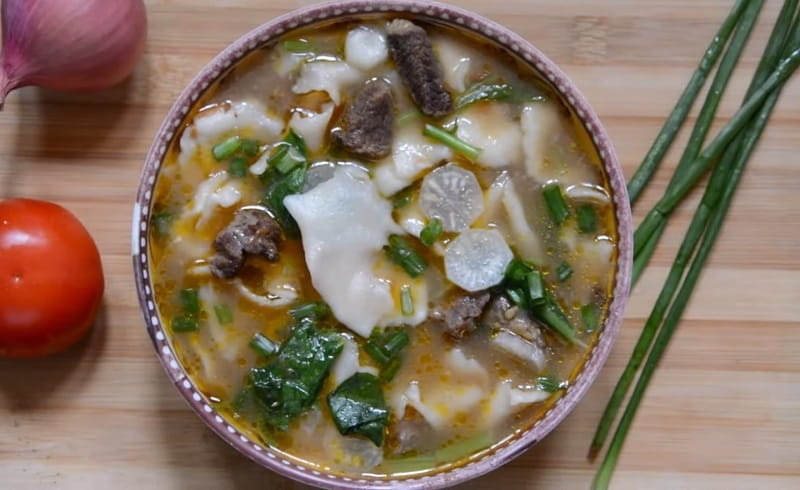
Thenthuk, or hand-pulled noodle soup, stands as a prominent dish in Tibetan cuisine, particularly in Amdo, Tibet, where it frequently graces dinner tables and occasionally lunch settings. This hearty soup comprises wheat flour dough, accompanied by mutton or yak meat, and an assortment of mixed vegetables. For those inclined towards a vegetarian option, vegetable thenthuk has become a popular choice in modern times. The soup-making process involves meticulous steps such as mixing and kneading the dough, chopping vegetables and meat, and boiling the soup to perfection.
The culinary journey reaches its climax when the cook, ensuring all components in the boiling soup are well-cooked, commences work on the dough. Expertly shaping, flattening, pulling, and cutting the dough directly into the simmering soup, the cook brings the dish to completion. Once this artful process concludes, the thenthuk is ready to cool down and be served, embodying the rich traditions and flavors of Tibetan cuisine.
Sha Phaley
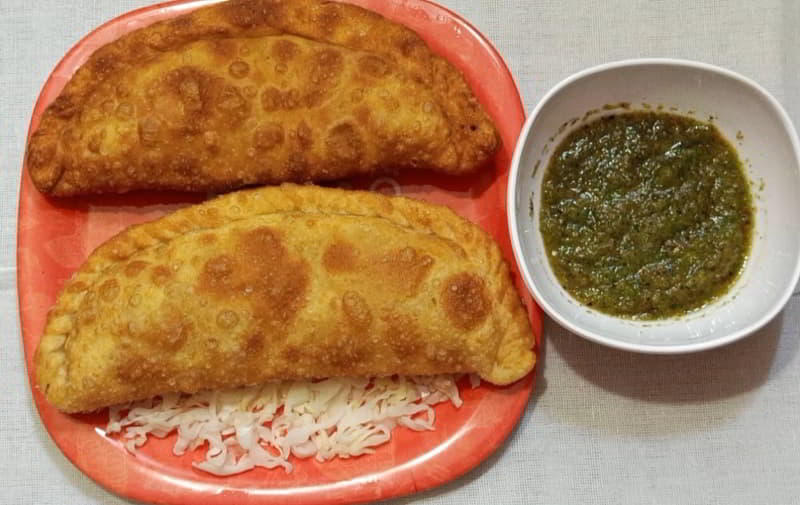
Shabhalep, alternatively known as sha phaley, is a Tibetan culinary delight consisting of bread filled with seasoned meat and cabbage. This delectable creation is skillfully shaped into semi-circular or circular forms, and its preparation method varies regionally—either undergoing deep-frying or being pan-fried akin to pot stickers. The heart of Shabhalep lies in the artful combination of well-seasoned meat and cabbage, creating a flavorful and satisfying experience for the palate.
This versatile dish, with its regional adaptations, reflects the diversity within Tibetan cuisine. The choice between deep-frying and pan-frying adds a layer of culinary nuance to Shabhalep, showcasing how traditional recipes can evolve based on local preferences. Whether enjoyed as a crispy deep-fried treat or a pan-fried delight reminiscent of pot stickers, Shabhalep stands as a testament to the culinary ingenuity present in Tibetan gastronomy.
Raksi

Raksi, known as a traditional distilled alcoholic beverage in Tibet, Nepal, and India, is often crafted in home settings. This potent libation, akin to vodka or gin in clarity, possesses a taste reminiscent of Japanese sake. Typically derived from kodo millet or rice, with each grain contributing distinct flavors, Raksi is produced through the distillation of chhaang, a brewed alcoholic beverage.
The Limbus and Kirati communities, valuing Raksi as part of their tradition, savor it in conjunction with tongba, accompanied by servings of water buffalo, goat meat sekuwa or pork. Among the Newars, aila holds a significant role in festivals and religious rituals, serving as libation, prasad, or sagan. The presentation of Raksi is often in a bhatti glass, and on special occasions, the beverage is theatrically poured from a pitcher with a small spout at a considerable height, creating an engaging spectacle. This multifaceted libation reflects not only diverse regional preferences but also cultural rituals and festive celebrations.
Yak Butter
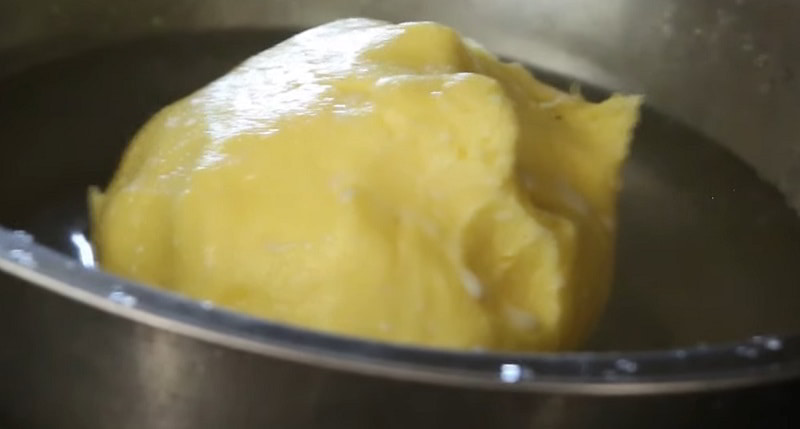
Yak Butter, crafted from the milk of domestic yaks (Bos grunniens), holds significance in the dietary practices of herder communities across Tibet, India, Nepal, Mongolia, Gilgit-Baltistan in Pakistan, and China. This dairy product, derived from yak's milk, carries twice the fat content of cow's milk, resulting in a butter with a texture resembling cheese. Renowned as a staple food and trade commodity in south Central Asia and the Tibetan Plateau, yak butter plays a pivotal role in the livelihoods of these herder communities.
In western Tibet, the process begins with fermenting yak's milk overnight. During summer, the fermented substance, akin to yogurt, undergoes an hour-long churning process using a wooden paddle plunged into a tall wooden churn. In winter, accumulated yogurt is poured into an inflated sheep's stomach, shaken until butter forms. This intricate method not only produces a vital food item but also underscores the cultural importance of yak butter in the daily lives and trade practices of the herder communities in this vast region.
Tingmo
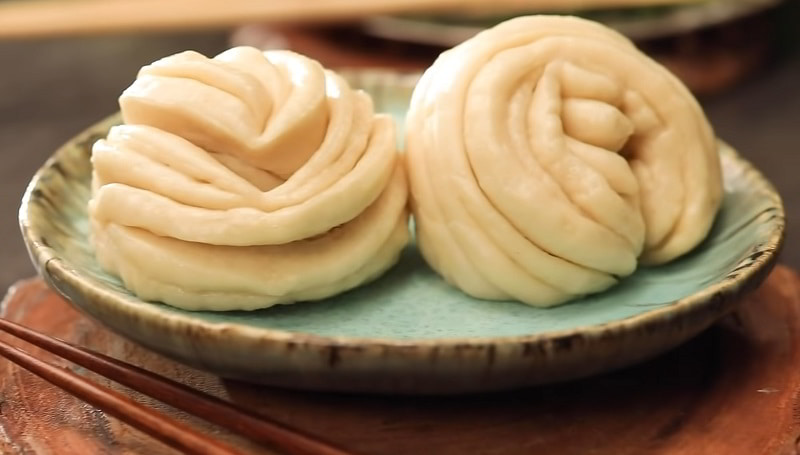
Tingmo, a steamed bread integral to Tibetan cuisine, is often likened to Chinese flower rolls, characterized by its soft and fluffy texture. Unlike its filled counterpart, the momo, tingmo stands out as a steamed bun without any internal filling. Typically served alongside vegetable dishes, dal dishes, meat preparations, and phing sha—a delightful combination of meat, wood ear mushrooms and cellophane noodles—tingmo complements various culinary offerings.
The etymology of tingmo is thought to stem from the Tibetan words tinga meaning cloud and momo translating to dumpling. This speculative origin alludes to the light and airy quality of the steamed bread. Tingmo plays a versatile role in Tibetan meals, providing a neutral and delightful accompaniment to diverse flavors. Its simplicity, coupled with the potential for creative pairings, reflects the culinary ingenuity within Tibetan gastronomy, where tingmo's cloud-like texture serves as a culinary canvas for an array of flavorful dishes.
Mokthuk
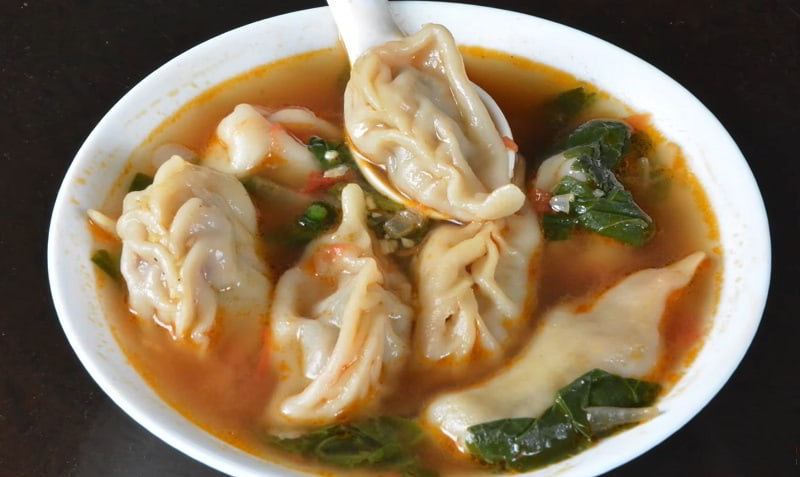
Mokthuk, a revered type of momo soup, has found popularity in regions including Tibet, Ladakh in northern India, and Nepal, with its origins rooted in Tibetan culinary traditions. This delightful creation amalgamates the essence of momo and thukpa, featuring smaller dumplings known as tsi-tsi momos. Distinguishing itself from the larger momos, Mokthuk, similar to jhol momo, boasts a distinctive broth. The soup base for Mokthuk is meticulously crafted using either meat bones infused with various herbs and vegetables or a vegetarian alternative.
The harmonious blend of flavors in Mokthuk reflects its Tibetan heritage, where culinary ingenuity results in a delectable fusion of momo and thukpa elements. Whether relished in the mountainous terrains of Tibet, the picturesque landscapes of Ladakh, or the vibrant culinary scene of Nepal, Mokthuk stands as a testament to the adaptability and creative evolution of traditional Tibetan cuisine across diverse regions.
Ara
-1703243276.jpg)
Ara, a traditional alcoholic beverage deeply ingrained in Bhutanese culture, is crafted from high-altitude tolerant grains such as millet, barley, maize, rice, or wheat. This libation, typically clear, creamy, or white in color, undergoes a process of either fermentation or distillation. Often produced at private homes or farms, rice or maize are common ingredients. While Ara's production is legally confined to private consumption in Bhutan, the unregulated methods and quality make its sale prohibited.
Beyond its culinary role, Ara holds cultural and religious significance. Produced for religious ceremonies, particularly in eastern Bhutan, it serves as a Lhasoel offering on auspicious occasions. Additionally, Ara is believed to possess snake-repelling properties, leading to children carrying it for protection. Traditionally consumed hot, Ara can be served neat or enhanced with smooth additives like butter and poached egg, or heartier options like scrambled egg and rice. The multifaceted role of Ara in Bhutanese life reflects its cultural, spiritual, and practical importance in the high-altitude landscapes of the region.
Balep Korkun
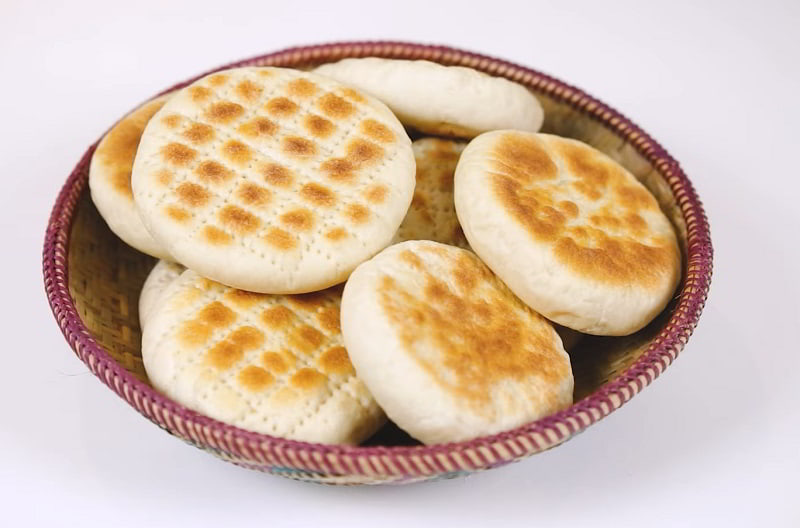
Balep Korkun, a staple in central Tibet, is a round, flat bread appreciated for its simplicity and ease of preparation. Comprising basic ingredients such as tsampa (barley flour), water, and baking powder, this bread is cooked on a frying pan, showcasing its straightforward cooking process. Resembling naan in appearance, Balep Korkun offers a delightful and practical addition to Tibetan meals. Its uncomplicated recipe, utilizing locally available ingredients, contributes to its popularity in central Tibet, reflecting the resourcefulness and adaptability inherent in Tibetan culinary traditions. This versatile bread not only satisfies the palate but also symbolizes the resilience and practicality of the Tibetan people in creating a nourishing and straightforward food item.
Thukpa Bhatuk
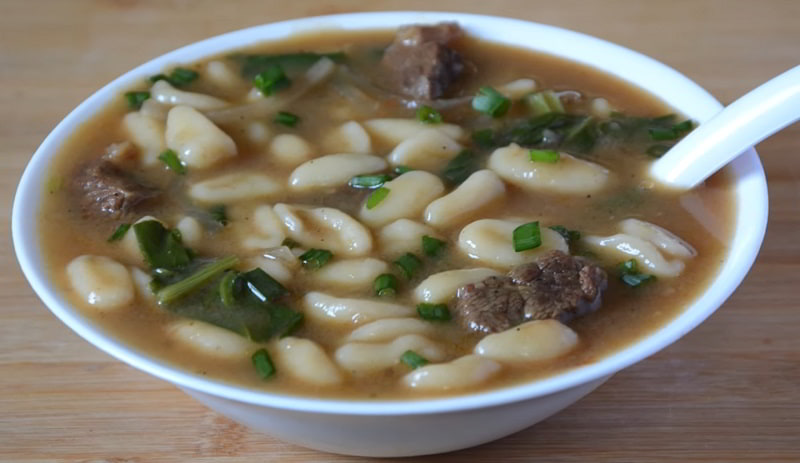
Thukpa Bhatuk, a prevalent noodle soup in Tibetan cuisine, features small Bhatsa noodles, making it a winter comfort dish and a significant element of Tibetan New Year festivities, particularly on Nyi-Shu-Gu, the eve of Losar. During this time, the familiar Thukpa Bhatuk takes on a special form known as Guthuk, prepared with unique ingredients. Consumed on Losar, Guthuk symbolizes shedding the negativity of the past year and welcoming positivity for the new one In the Thukpa Bhatuk soup, the star elements are the handmade Bhatsa noodles, resembling Italian gnocchi. Two varieties of Bhatsa noodles used are Gutsi Rithuk and Bhatuk, collectively referred to as Bhatuk in Central Tibet. The soup typically incorporates meat, such as mutton, beef, or yak; however, a vegetarian version can be crafted using vegetable bouillon.
Thukpa Bhatuk embodies the heartiness of Tibetan winter fare, with its unique variations adding a touch of cultural significance to festive occasions, marking the transition into a hopeful new year.
Tibetan Cheese
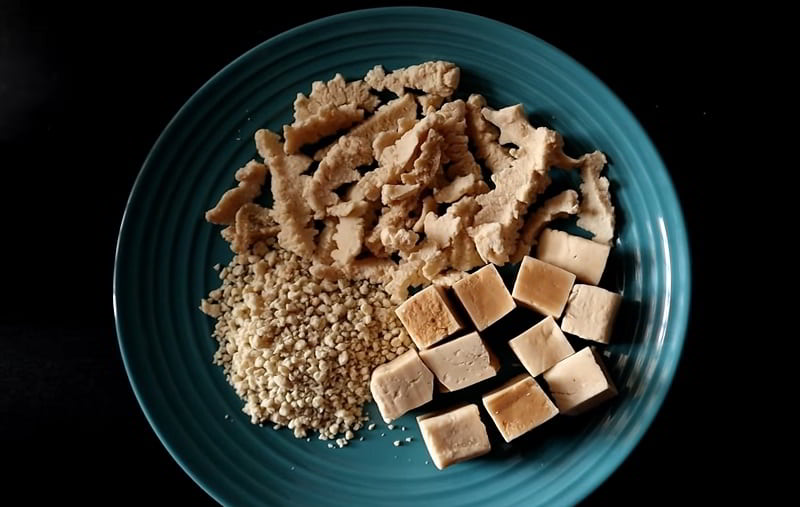
Cheese is a fundamental element in Tibetan cuisine, offering a diverse array of textures and flavors. Soft cheese curds, akin to cottage cheese and crafted from buttermilk, are known as chura loenpa (or ser). The harder variety is referred to as chura kampo. Notably, the extra hard chhurpi is produced from solidified yogurt, a specialty found not only in Tibet but also in regions like Sikkim and Nepal. Another cheese variant, shosha or churul, distinguished by a Limburger-like flavor, is fashioned from cream and milk skin, adding a unique taste profile to Tibetan culinary offerings.
These cheeses, integral to Tibetan gastronomy, showcase the resourcefulness of the region's dairy traditions. From the soft and crumbly textures of chura loenpa to the robust and aged notes of chura kampo and chhurpi, Tibetan cheese reflects the rich diversity in flavors and culinary techniques embedded in this Himalayan cuisine.
Khapse
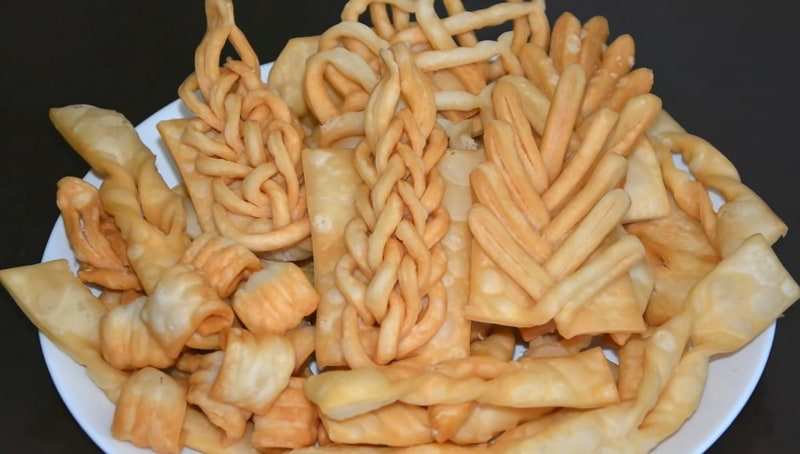
Khapse, a cherished Tibetan biscuit, holds deep cultural significance as a traditional treat associated with the Tibetan New Year, or Losar. Crafted from a dough comprising eggs, flour, sugar, and butter, Khapse comes to life in various shapes and sizes, each holding a symbolic meaning. Some are adorned with a sprinkle of powdered sugar, while others, like the distinctive donkey ear-shaped khapseys, boast intricate decorations.
This festive biscuit not only delights the taste buds but also plays a crucial role in the celebration of Losar, symbolizing good wishes and positive beginnings. The diverse shapes of Khapse reflect the creativity and cultural nuances embedded in Tibetan traditions, where culinary artistry becomes a medium to express festive joy and communal spirit. Whether enjoyed as a sweet indulgence or shared as a token of goodwill during Losar festivities, Khapse stands as a testament to the rich cultural heritage and warm traditions of the Tibetan people.
Gyurma
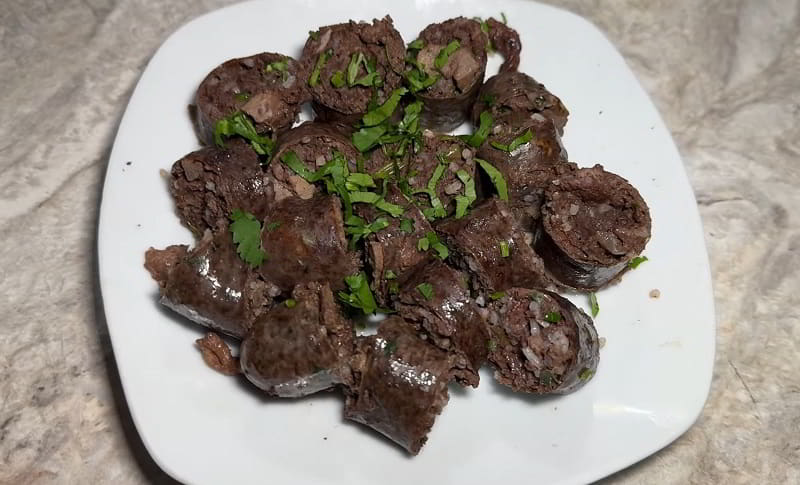
Gyurma, a distinctive blood sausage rooted in Tibetan cuisine, is crafted using yak or sheep's blood, enriched with either rice or roasted barley flour as a filling. Encased in natural yak or sheep casing, typically sourced from the intestines, this sausage showcases the resourcefulness and cultural flavors intrinsic to Tibetan culinary practices. Beyond Tibet, Gyurma extends its influence to regions such as Sikkim, Bhutan, Uttarakhand, Ladakh in India, and the Himalayan areas of Nepal, reflecting its widespread acceptance and adaptation across the Himalayan belt.
Embraced in various Himalayan communities, Gyurma mirrors the dynamic culinary tapestry of the region. The utilization of local ingredients, including blood and casing, signifies both practicality and cultural symbolism. Whether enjoyed in the high-altitude landscapes of Tibet or savored in the diverse culinary traditions of the Himalayan foothills, Gyurma stands as a testament to the inventive use of ingredients in creating a unique and flavorsome sausage.
Guthuk
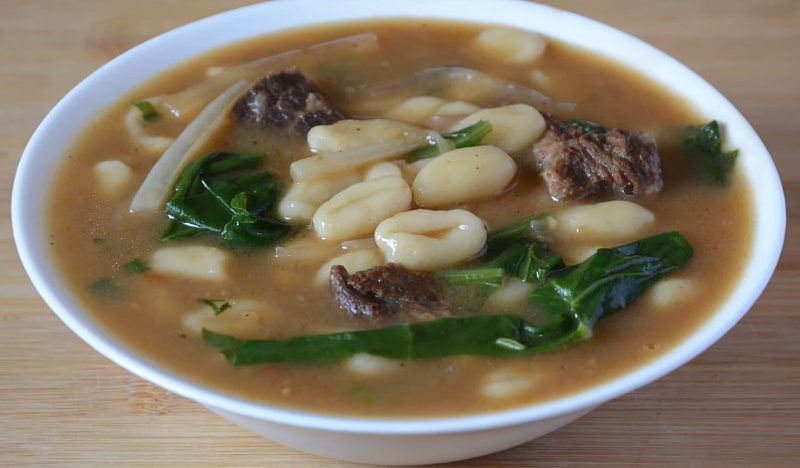
Guthuk, a hearty stew soup deeply embedded in Sherpa and Tibetan cuisine, embodies a rich medley of ingredients such as beans, vegetables, and meat, often utilizing leftover harvested grains. Consumed two days before Losar, the Tibetan New Year, Guthuk stands as a unique variation of thukpa bhatuk, contributing to the festive culinary traditions.
Crafted in anticipation of Losar, Guthuk gains heightened importance during the Tibetan religious observance of Gutor. This ceremony focuses on dispelling negativity, including evil spirits and misfortunes from the past year, ushering in the new year with peace and auspicious beginnings. Barley, a staple in the region, forms a foundational element in the preparation of Guthuk, intertwining practical sustenance with cultural and spiritual rituals. This wholesome stew soup reflects the cultural depth and symbolic importance embedded in the gastronomic traditions surrounding Losar in the Sherpa and Tibetan communities.
Tu (Cheesecake)
-1707375854.jpg)
Tu Cake, a beloved delicacy in Tibetan cuisine, is a testament to the rich flavors of the region. This delectable treat is meticulously crafted using yak butter, brown sugar, and water, resulting in a unique and delightful pastry. The combination of these simple yet distinctive ingredients creates a rich and flavorful cake that holds a special place in Tibetan culinary traditions. Often enjoyed as a sweet indulgence, Tu Cake reflects the cultural richness and culinary ingenuity of Tibet, offering a taste of tradition and a delightful experience for those fortunate enough to savor its distinctive flavors.
Yurla (Wheat Pastry)
-1707480358.jpg)
Yurla, a cherished specialty in Tibetan cuisine, is a wheat pastry that epitomizes the culinary artistry of the region. This delectable treat, distinguished by its use of butter, holds a significant place in the hearts and palates of those who savor its unique flavors. Particularly celebrated in Nyainrong County in northern Tibet, Yurla showcases the local commitment to using simple yet high-quality ingredients. The combination of wheat and butter creates a pastry with a rich, satisfying taste, reflecting the cultural richness and culinary heritage of Tibetan gastronomy. Whether enjoyed as a sweet indulgence or a cultural staple, Yurla stands as a symbol of the region's culinary ingenuity and the art of crafting delightful treats from local resources.
Chura Kampo
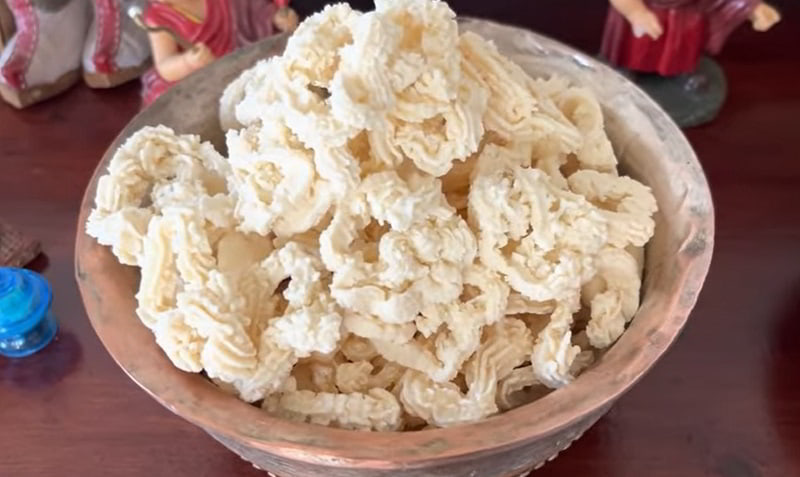
Chura kampo, a distinctive element in Tibetan culinary culture, stands out as a flavorful and enduring Tibetan dried cheese. Crafted from the remnants of buttermilk curds, it takes on various shapes, offering versatility in both its creation and consumption. Encountered in small, resilient chunks, chura kampo is relished much like Western candy bars, delivering a sustained and rich chewing experience. Its lasting nature and unique taste reflect the resourceful use of local ingredients, contributing to the robust flavors deeply rooted in Tibetan culinary heritage. Beyond being a mere cheese, chura kampo embodies the culinary ingenuity and cultural richness that make it an essential part of the diverse and enduring tapestry of Tibetan cuisine.
Masan (Pastry)

Masen, a cherished creation within Tibetan cuisine, serves as a remarkable expression of the region's culinary craftsmanship. This pastry, intricately fashioned from a blend of indigenous elements such as tsampa, yak butter, dry cubic or curd cheese, water, and brown sugar, mirrors the cultural abundance and inventive traditions ingrained in Tibetan culinary legacy. Beyond a mere treat, Masen encapsulates the profound link between the people, their locally sourced ingredients, and the enduring practices that shape Tibet's distinctive flavors. Whether savored as a sweet indulgence or seamlessly integrated into daily life, Masen encapsulates the essence of a culture narrated through its unique and delightful culinary contributions.
Shosha (Cheese)
-1707377171.jpg)
Shosha, alternatively known as churul or churu, represents a variety of soft cheese integral to Tibetan cuisine. Serving as a staple food, Tibetan cheese is typically crafted from animals well-adapted to the climate, such as yak and goat. Notably pungent, akin to blue cheese, Shosha is employed in various culinary applications, including beef dishes and the preparation of churu cheese soup. This distinctive cheese adds a robust flavor profile to Tibetan gastronomy, showcasing the region's reliance on locally available resources and the creative use of dairy products in crafting flavorful and traditional dishes.
Gyabrag
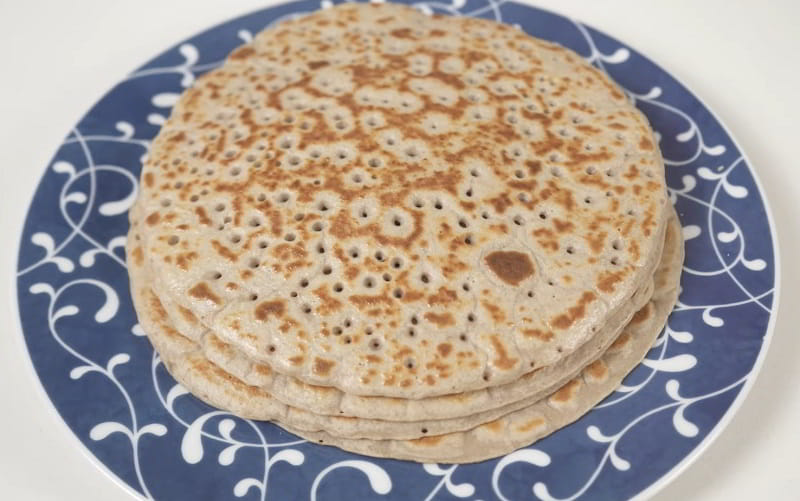
Gyabrag, a culinary gem in Tibetan cuisine, emerges as a delectable pancake boasting a unique blend of flavors. Crafted with precision, this pancake is an intricate composition of barley flour, imparting a hearty texture. The inclusion of dry cheese curds adds a savory richness, complemented by the distinctive essence of yak butter, a staple in Tibetan dairy traditions. To balance the flavors, a touch of sugar brings a subtle sweetness, creating a harmonious interplay on the palate. Gyabrag not only showcases the resourceful use of local ingredients but also represents the cultural intricacies embedded in Tibetan gastronomy. Whether enjoyed as a delightful snack or part of a larger meal, Gyabrag encapsulates the essence of Tibetan culinary heritage, where each ingredient plays a vital role in creating a wholesome and flavorful experience.
Gundain
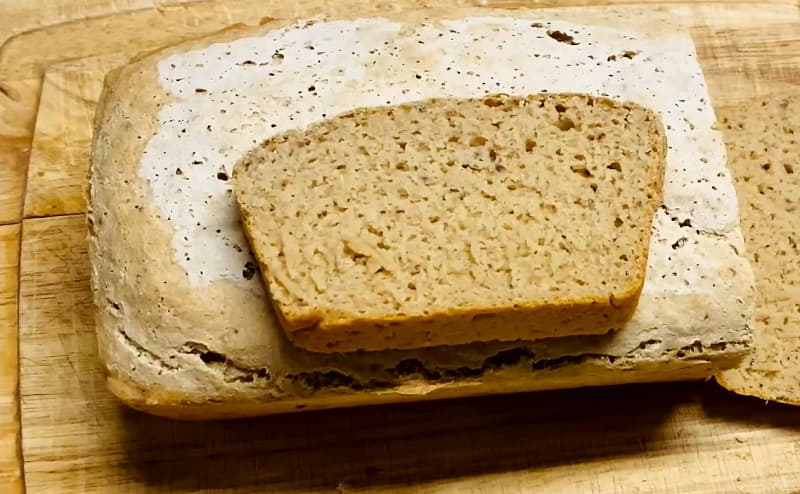
Gundain, a distinguished pastry within Tibetan cuisine, embodies a unique blend of flavors crafted from yeast, fermented into a light barley beer and barley grain. This pastry is elevated with the addition of tsampa, wild ginseng, dry curd cheese, and brown sugar. Traditionally savored during significant celebrations like the Tibetan New Year and Losar, Gundain holds a special place as a starter in festive feasts. The barley beer infusion brings a subtle depth to the pastry, while the combination of tsampa, curd cheese, wild ginseng, and brown sugar creates a harmonious medley of tastes. Beyond being a delightful treat, Gundain reflects the cultural richness and festive traditions embedded in Tibetan culinary heritage, making it a symbol of joy and celebration during important occasions.
Balep
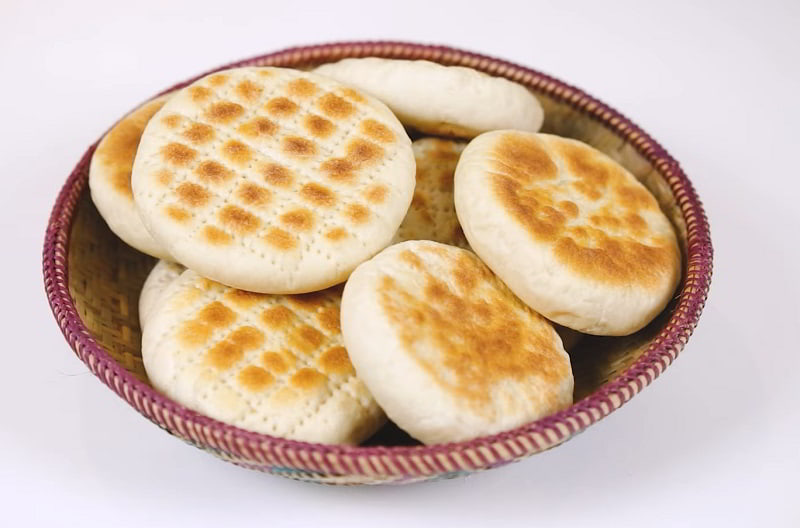
Balep, a quintessential Tibetan bannock quickbread, holds a prominent place in Tibetan cuisine with various regional variations. Amdo Balep, originating from the Amdo region, takes on a rounded form, showcasing the diversity in Tibetan bread styles. Sha balep introduces a savory twist with fried beef pies, offering a flavorful alternative. Numtrak balep explores the deep-fried realm of bread, presenting a delightful variation in texture. Balep korkun, pan-cooked to perfection, provides a unique culinary experience with its distinct preparation method. The array expands with Shamey balep, introducing fried pies that contribute to the rich tapestry of Tibetan bread varieties. These different iterations of 'Balep' not only highlight the culinary ingenuity but also underscore the regional diversity within Tibetan gastronomy, where each type brings its own unique charm to the cultural and culinary heritage of Tibet.
Xabbatog

Xabbatog, a standout in Tibetan cuisine, is a delectable creation featuring dough filled with a delightful combination of shredded turnips and dry curd cheese. This unique dish undergoes a culinary transformation as it is skillfully cooked in bone soup, infusing it with rich flavors and textures. Xabbatog showcases the culinary ingenuity present in Tibetan gastronomy, where simple yet harmonious ingredients are crafted into a savory delight. Whether enjoyed as a comforting soup or a hearty main dish, xabbatog encapsulates the essence of Tibetan cuisine, where the balance of flavors and cultural traditions converge to create a memorable culinary experience.
Chura Loenpa
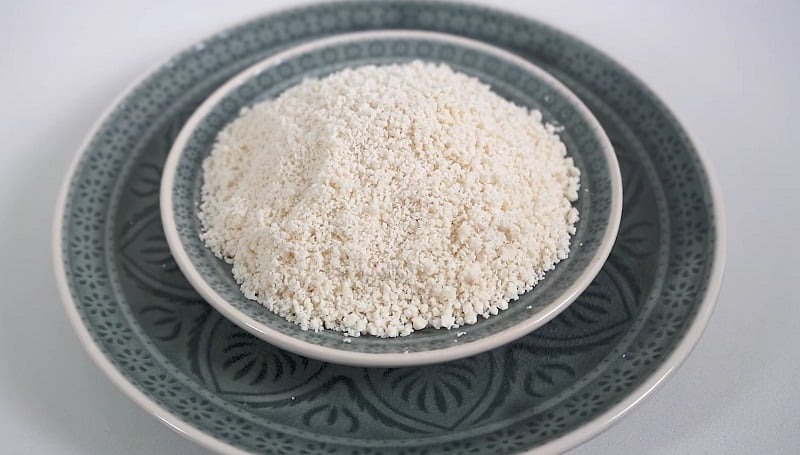
Chura loenpa, a significant element in Tibetan cuisine, stands as a soft cheese of importance within the rich gastronomic tapestry of Tibet. Resembling cottage cheese, this delicacy is crafted from the residual curds derived from the boiling of buttermilk. The process results in a soft and creamy texture, contributing to the versatile nature of chura loenpa in Tibetan culinary creations. This cheese, both distinctive and integral, mirrors the resourceful use of locally available ingredients, capturing the essence of Tibetan culinary heritage. Whether enjoyed on its own or incorporated into various dishes, chura loenpa showcases the delicate balance of flavors and the cultural richness embedded in Tibetan culinary traditions.
De-Thuk

De-Thuk, a significant soup in Tibetan cuisine, weaves together the essence of Tibetan flavors with a foundation of yak or sheep broth. Enriched by rice, diverse Tibetan cheeses, and the unique droma root, this soup embodies the culinary richness of the region. The rice undergoes careful cooking in ample water or stock, creating a texture reminiscent of Cantonese rice congee. This distinctive blend of ingredients results in a harmonious and comforting dish, highlighting the ingenious use of local resources and traditional practices within Tibetan food culture. Whether valued for its comforting warmth or appreciated as a nuanced culinary experience, De-Thuk serves as a reflection of the cultural and culinary diversity that characterizes Tibetan cuisine.
Zhoixo

In Tibetan cuisine, Zhoixo emerges as a distinctive dish crafted from the infusion of wild ginseng and yogurt. This unique combination showcases the region's culinary creativity, blending the earthy notes of wild ginseng with the creamy texture and tanginess of yogurt. The inclusion of wild ginseng, celebrated for its medicinal properties, adds a nuanced depth to the dish, creating a harmonious balance of flavors. Zhoixo not only reflects the resourceful use of indigenous ingredients but also underscores the cultural significance of traditional elements in Tibetan culinary practices. Whether appreciated for its potential health benefits or savored for its unique taste, Zhoixo stands as a testament to the ingenuity and cultural richness embedded in Tibetan gastronomy, where the fusion of flavors becomes a celebration of both nourishment and tradition.
Xogoi Momo
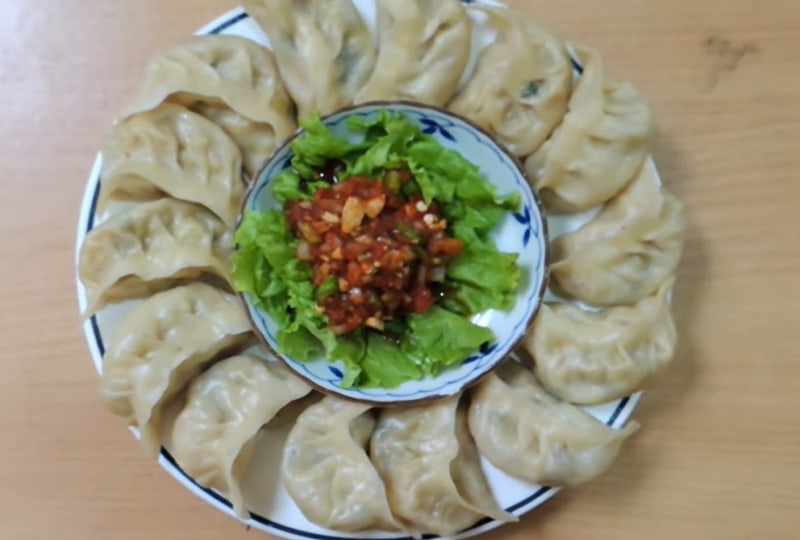
In Tibetan cuisine, a xogoi momo stands out as a distinctive variation of the traditional momo, featuring mashed potato incorporated into the dough. The preparation involves shaping this unique blend into flavorful balls, generously filled with minced meat, and delicately coated with bread crumbs. This culinary innovation showcases the adaptability of Tibetan momos, where the starchy richness of mashed potato enhances the texture and taste of the dough. The addition of a savory minced meat filling complements the overall dish, creating a delightful interplay of flavors and textures. The finishing touch of a crisp bread crumb coating adds an extra layer of indulgence. Xogoi momo not only exemplifies the inventive spirit within Tibetan gastronomy but also underscores the diversity and creativity present in the evolution of traditional dishes. Whether enjoyed for its unique twist or as a comforting delicacy, xogoi momo reflects the culinary artistry inherent in Tibetan cuisine.
Sokham Bexe
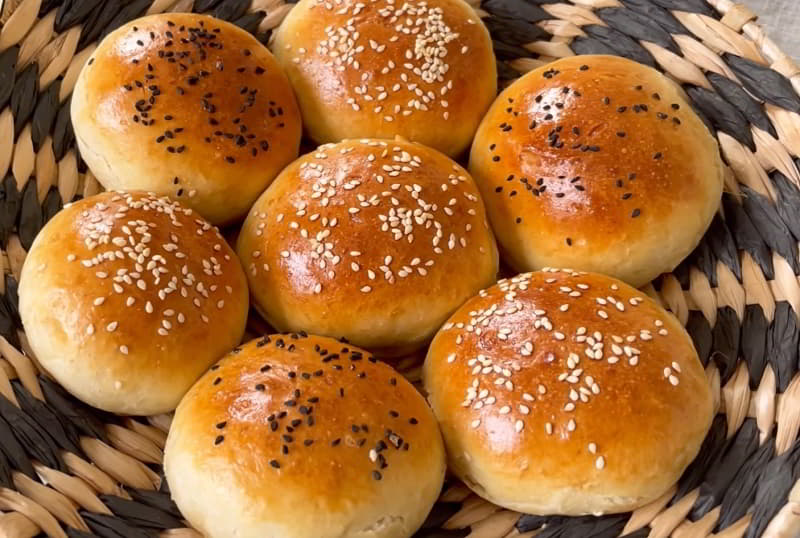
In Tibetan culinary tradition, Sokham Bexe emerges as a cherished delight—a fried dough enriched with butter and minced meat. Notably celebrated as a favorite among esteemed figures like the Dalai Lama and the Panchen Lama, this dish holds cultural significance beyond its delectable taste. The combination of golden-fried dough, buttery richness, and savory minced meat encapsulates the essence of Tibetan culinary heritage. Sokham Bexe stands as a testament to the enduring appeal of traditional flavors, its popularity among revered leaders echoing its cultural importance. Beyond being a palatable treat, this dish symbolizes the intersection of taste, tradition, and the cultural threads that weave through Tibetan cuisine, creating a connection between the past and the present.
Lunggoi Katsa

Within Tibetan cuisine, Lunggoi Katsa takes center stage as a stewed sheep's head infused with a flavorful medley of curry, monosodium glutamate, fennel, and salt. This dish reflects the culinary traditions of the region, where the distinct flavors of the stewed sheep's head are enhanced by the aromatic notes of curry and fennel, creating a robust and savory experience. The addition of monosodium glutamate and salt contributes to the overall seasoning, ensuring a well-balanced taste. Lunggoi Katsa not only serves as a testament to the resourceful use of local ingredients but also stands as a symbol of the culinary diversity and richness within Tibetan gastronomy. Whether appreciated for its hearty flavors or embraced as a cultural specialty, Lunggoi Katsa embodies the essence of tradition and taste in Tibetan cuisine.
Thue (food)
-1707382864.jpg)
Thue, a delectable treat in Tibetan cuisine, is crafted from dri cheese or other hard cheeses like parmesan, brown sugar, and unsalted sweet cream butter. This culinary masterpiece involves a hands-on process, blending these ingredients into a smooth, slightly crumbly dough with a rich buttery texture. Shaped within a thuedrom, a rectangular wooden frame resembling a small brick, Thue boasts a high butter content that defines its luscious consistency. The artistry of Thue extends to its presentation, often adorned with intricately carved representations of the moon and the sun, sculpted from chilled butter. Serving as one of the rare sweet offerings in Tibetan cuisine, Thue takes center stage as a dessert, celebrated during Losar, the Sho Dun Festival, weddings, and other special occasions. This delightful treat not only tantalizes the taste buds but also symbolizes the intersection of craftsmanship, tradition, and celebration within the rich tapestry of Tibetan culinary heritage.
Tsam-thuk
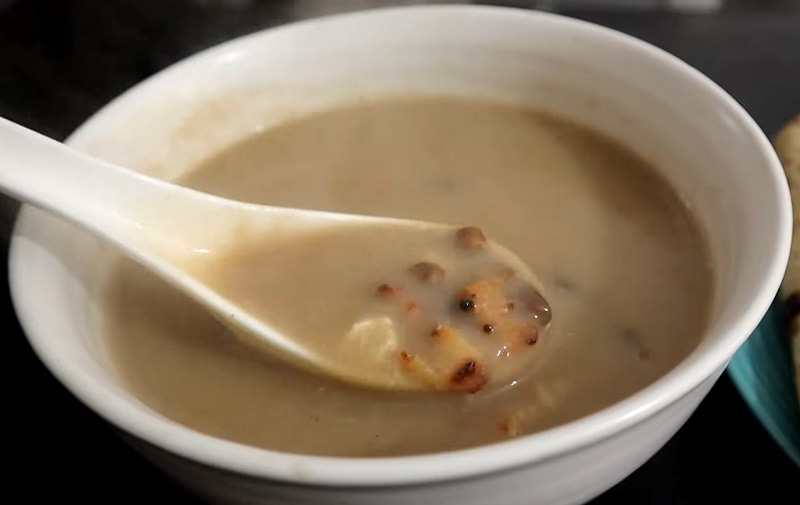
Tsam-thuk, a distinctive Tibetan soup, intertwines the essence of yak or sheep soup stock with the heartiness of tsampa (roasted barley flour) and an array of Tibetan cheeses. This soul-nourishing creation not only reflects the depth of Tibetan culinary heritage but also embodies the resourceful use of local ingredients.
Tsam-thuk's versatility extends to its serving temperature, with the option to be enjoyed at room temperature, allowing for a comforting experience irrespective of the season. The harmonious blend of flavors in this soup encapsulates the culinary richness of Tibet, offering a sensory journey through its unique combination of ingredients. Tsam-thuk stands as a testament to the cultural significance embedded in Tibetan cuisine, where each spoonful carries the legacy of traditional flavors and nourishment.
Sepen (sauce)
-1707383024.jpg)
Sepen, a fiery gem in Tibetan cuisine, emerges as a potent hot sauce, its core comprised of vibrant chillies heightened by an array of spices, varying with each recipe. This versatile condiment showcases diverse renditions—some anchored in a tomato base, while others integrate vegetables like onion and celery, contributing nuanced flavors. Sepen manifests in both thick, chunky variations and smoother renditions, offering a spectrum of textures to elevate Tibetan dishes. This dynamic hot sauce transcends mere culinary function, becoming an essential companion to every meal, enriching the typically mild Tibetan fare with a burst of heat and intensity.
Sepen's significance surpasses its role as a condiment, standing as a flavorful testament to the inventive versatility found within Tibetan culinary traditions. This spicy creation enhances and deepens the dining experience, contributing zest to every meal in the rich tapestry of Tibetan cuisine.
Cheser mog

In Tibetan culinary tradition, cheser mog unfolds as a simple yet soul-satisfying dish, harmonizing rice with the richness of melted yak butter, the sweetness of brown sugar, the chewy delight of raisins, and a subtle touch of salt. This amalgamation creates a symphony of flavors and textures, reflecting the resourceful use of indigenous ingredients in Tibetan gastronomy. Cheser mog embodies the essence of comfort and tradition, offering a taste of the region's culinary heritage. Whether enjoyed as a nourishing staple or savored on special occasions, this dish resonates with the heartiness and simplicity that characterize Tibetan cuisine, creating a connection between the diner and the cultural tapestry woven through each grain of rice.
Xab Pagri

Within Tibetan culinary traditions, Xab Pagri stands out as a savory creation—a baked dough patty generously filled with flavorful meat paste. This culinary delight reflects the rich tapestry of Tibetan cuisine, seamlessly blending the comforting texture of baked dough with the robust, savory essence of the meat filling. The interplay of textures, from the crispy exterior to the succulent meat interior, offers a satisfying experience. Xab Pagri not only exemplifies the resourceful use of local ingredients but also serves as a cultural symbol, representing the diverse flavors deeply embedded in Tibetan culinary heritage. Whether enjoyed as a wholesome snack or as part of festive occasions, Xab Pagri attests to the culinary craftsmanship and cultural significance inherent in Tibetan culinary traditions.
Sha Shingbee
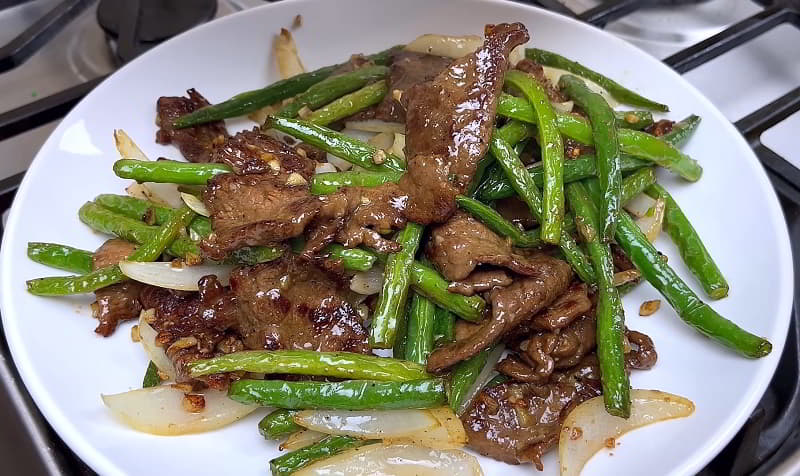
Sha Shingbee, a tantalizing stir-fry hailing from Tibetan cuisine, showcases the culinary ingenuity of the region through a medley of sliced mutton and vibrant green beans. This dish, characterized by its skillful stir-frying technique, results in a symphony of flavors and textures. The succulent mutton, sliced to perfection, harmonizes with the crispness of green beans, creating a delightful contrast in every bite. Sha Shingbee not only exemplifies the art of stir-fry but also pays homage to the simplicity and freshness of ingredients inherent in Tibetan culinary traditions.
Whether enjoyed as a comforting home-cooked meal or presented as a culinary delight in festive gatherings, Sha Shingbee stands as a testament to the cultural richness and flavors woven into the fabric of Tibetan cooking.
Flower of Rajya
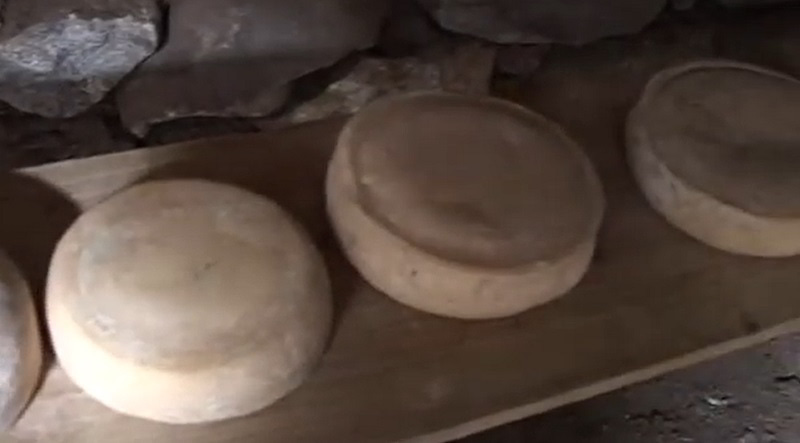
Flower of Rajya, an artisanal creation in the heart of Nepal, unfolds as a robust yak's-milk cheese crafted through a collaboration between Tibetan nomads and the Trace Foundation. The cheese-making process begins with the heating and ripening of milk in substantial copper vats, followed by curdling, draining, and molding into sizable 10–12 lb (4.5–5.4 kg) wheels. To impart distinctive flavor and texture, the cheese undergoes a meticulous dry-curing process, utilizing Tibetan red salt. Aging follows, culminating in a cheese adorned with scarves, lovingly packed into bamboo baskets.
This culinary masterpiece not only showcases the artisanal expertise of Tibetan nomads but also represents a harmonious fusion of tradition, craftsmanship, and the unique terroir of the region, elevating Flower of Rajya into a symbol of cultural heritage and gastronomic excellence.
Sweet sour and spicy vegetable gravy

A quintessential element of Tibetan culinary traditions, this vegetable curry, akin to a hearty soup, pairs seamlessly with tingmo steamed bread. This traditional combination reflects the rich tapestry of Tibetan flavors, offering a comforting and satisfying dining experience. The vegetable curry, infused with an array of vibrant ingredients, complements the tingmo steamed bread, creating a harmonious interplay of textures and tastes. Rooted in the region's culinary heritage, this pairing exemplifies the synergy of flavors that characterizes Tibetan cuisine, providing both sustenance and a delightful culinary journey. Whether enjoyed in daily meals or presented during festive occasions, the soup-like vegetable curry alongside tingmo steamed bread encapsulates the cultural significance and delectable diversity inherent in Tibetan culinary practices.
Papza Mogu
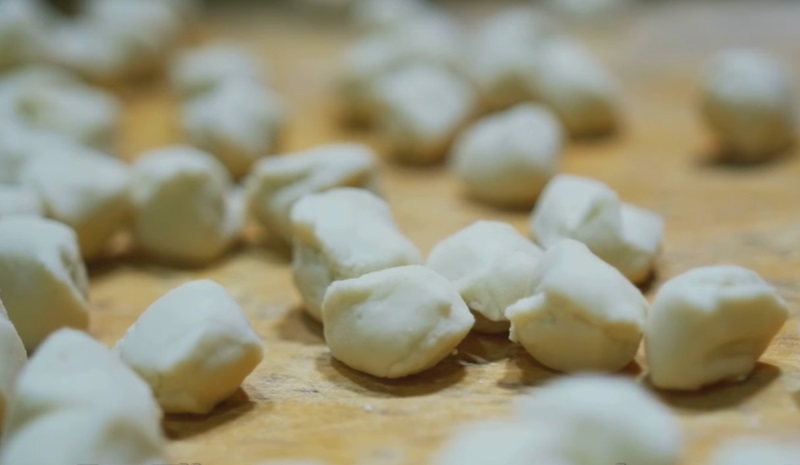
Within the realm of Tibetan cuisine, papza mogu emerges as a distinctive creation—a dough skillfully shaped into balls, interweaving the richness of melted butter, the sweetness of brown sugar, and the delightful texture of dry curd cheese. This culinary fusion delivers a harmonious blend of sweet and sour notes, creating a sensory experience that resonates with the vibrant flavors of the region. The distinctive red hue adds to its visual allure, making papza mogu not just a delightful treat but also a feast for the eyes. Whether relished as a sweet indulgence or savored on special occasions, this unique creation encapsulates the spirit of Tibetan cuisine, where each element contributes to a flavorful and visually enticing culinary journey.
Drokpa Katsa
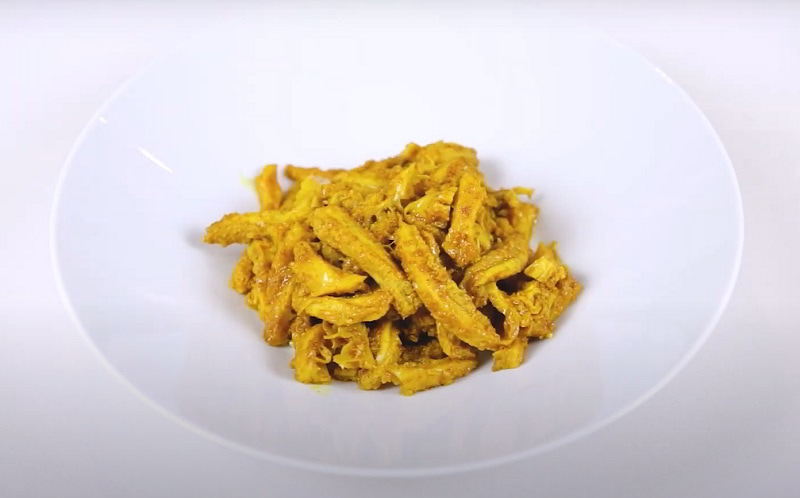
Drokpa katsa, a distinctive dish in Tibetan cuisine, features tender stewed tripe infused with a flavorful blend of curry, fennel, monosodium glutamate, and salt. This culinary creation captures the essence of Tibetan flavors, offering a savory and aromatic experience. The meticulous stewing process ensures the tripe achieves a delectable tenderness, while the curated spice blend imparts depth and richness. Rooted in traditional culinary practices, drokpa katsa stands as a testament to the region's gastronomic heritage. Whether enjoyed as a comforting home-cooked meal or presented during special occasions, this dish reflects the culinary artistry and cultural significance deeply ingrained in Tibetan cuisine.
Lowa Khatsa
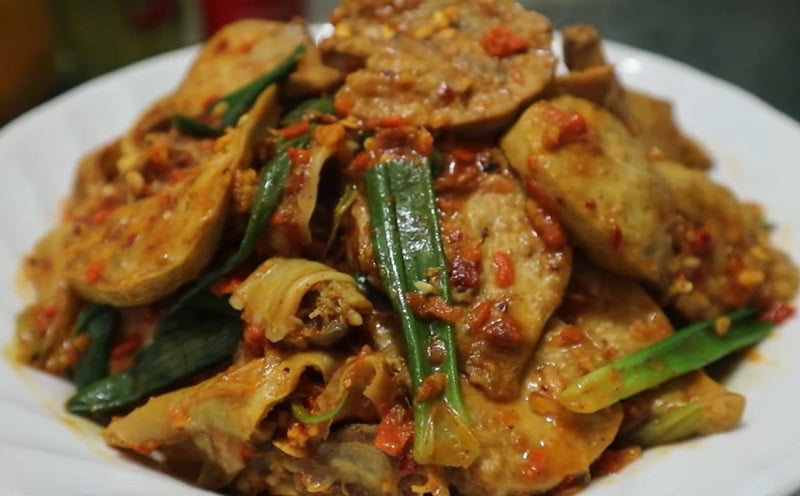
Lowa Khatsa, a distinctive dish in Tibetan culinary traditions, features pieces of fried animal lung, delivering a unique and flavorful experience. This dish reflects the resourcefulness and distinct culinary preferences of the region, where the fried animal lung is prepared to achieve a crispy texture. The simplicity of its preparation allows the natural flavors of the main ingredient to shine through, creating a dish that holds cultural significance and historical roots. Whether savored as a local delicacy or enjoyed during festive gatherings, Lowa Khatsa stands as a testament to the diverse and distinctive flavors embedded in Tibetan culinary heritage.
Qoiri
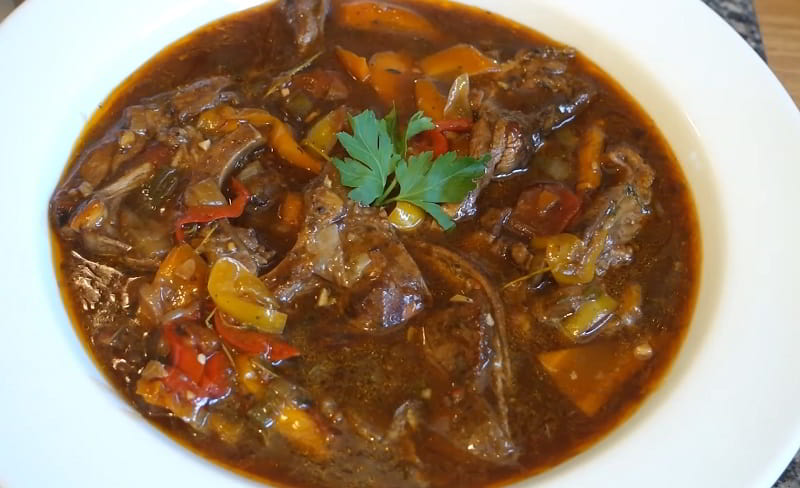
Qoiri, a hearty stew entrenched in Tibetan culinary traditions, weaves together an array of essential ingredients, including succulent mutton chops, shredded wheat, flour, dry curd cheese, chillies, salt and water. This flavorful medley captures the essence of Tibetan flavors, showcasing a meticulous balance of spice, texture, and richness. The Moinba people of southwestern Tibet elevate this dish by introducing a robust cheese variant and enhancing its complexity with additions like wild mushrooms and fungi.
This culinary symphony not only reflects the diversity within Tibetan cuisine but also pays homage to the regional variations that enrich the gastronomic tapestry. Whether enjoyed as a comforting home-cooked meal or as part of festive gatherings, Qoiri stands as a testament to the culinary artistry and cultural heritage deeply ingrained in Tibetan culinary practices.
Dre-si
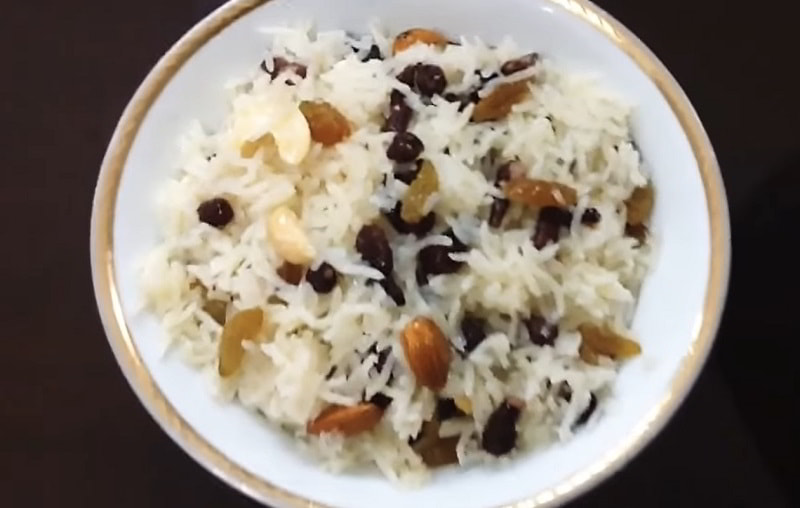
De-si, a cherished sweet delicacy within Tibetan culinary traditions, unfolds as a symphony of flavors and textures. This indulgent dish features rice, carefully cooked in unsalted butter, and interwoven with the natural sweetness of raisins, droma (a native Tibetan tuber), dates, and nuts. Its creation is a labor of love, usually reserved for the auspicious occasion of Losar, the Tibetan New Year. This festive treat not only delights the palate with its rich, buttery essence but also encapsulates the spirit of celebratory gatherings. De-si stands as a cultural hallmark, its appearance marking the joyous festivities of Losar, where the melding of ingredients mirrors the unity and warmth found within Tibetan communities during moments of communal revelry.
Samkham Papleg
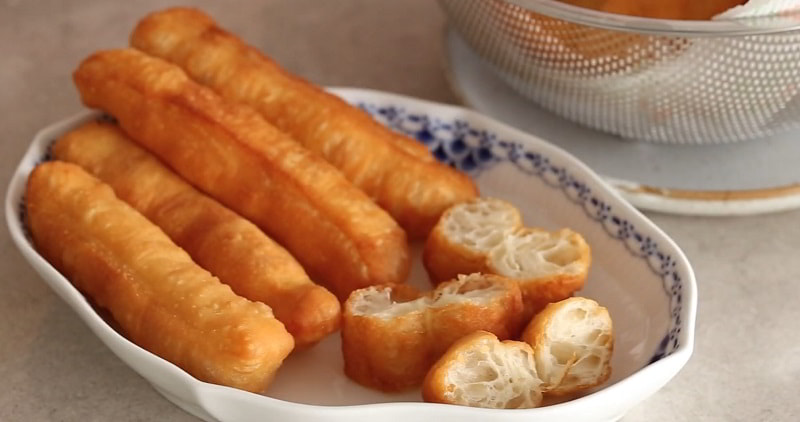
Samkham Papleg, a delectable creation in Tibetan culinary traditions, emerges as fried dough enriched with the essence of yak butter or rapeseed oil. This simple yet delightful dish embodies the spirit of resourceful cooking, utilizing locally available ingredients to craft a satisfying treat. The preparation involves a careful dance of flavors and textures, resulting in a golden-brown delight that captivates the senses. Whether enjoyed as a comforting snack or part of festive celebrations, Samkham Papleg reflects the ingenuity of Tibetan cuisine, where humble ingredients are transformed into culinary treasures. This fried dough, bathed in the wholesome richness of yak butter or rapeseed oil, serves not just as sustenance but as a cultural emblem, connecting individuals to the time-honored culinary practices that define the heart and soul of Tibetan cuisine.
Shab Tra
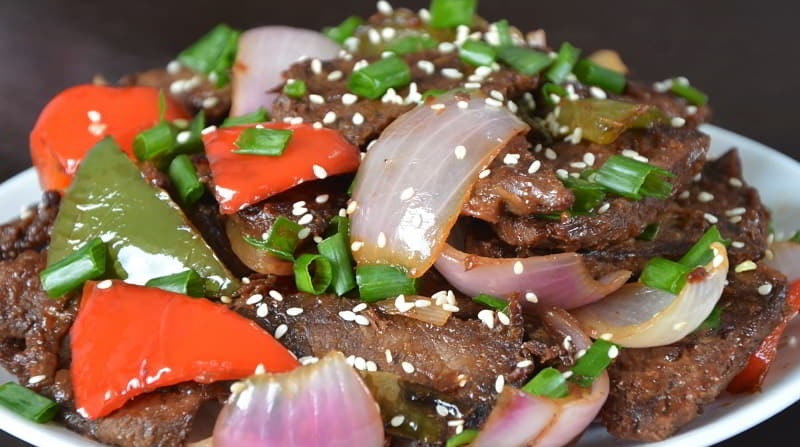
Shab Tra, a tantalizing dish within Tibetan culinary traditions, features stir-fried meat skillfully combined with vibrant celery, carrots, and lively green chili. This flavorful ensemble showcases the artistry of Tibetan cuisine, where ingredients are thoughtfully chosen to create a harmonious medley of textures and tastes. The stir-frying technique enhances the natural flavors, resulting in a savory and aromatic delight. Shab Tra's appeal lies in its simplicity and the vibrant interplay of fresh ingredients, making it a beloved choice whether savored as a comforting home-cooked meal or shared during communal gatherings. This dish not only satisfies the palate but also embodies the cultural richness ingrained in Tibetan culinary practices, connecting individuals to the flavors and traditions that define their culinary heritage.
Chetang Goiche

Chetang goiche, a delightful offering in Tibetan culinary traditions, unfolds as strips of dough expertly fried with the richness of rapeseed oil and the subtle sweetness of brown sugar. This uncomplicated yet flavorful creation showcases the artistry of Tibetan cuisine, where humble ingredients are transformed into a delectable treat. The process involves a careful balance, resulting in golden-brown strips that boast a perfect harmony of textures and tastes. Whether relished as a cherished snack or shared during festive occasions, chetang goiche encapsulates the essence of Tibetan gastronomy—simple, satisfying, and deeply rooted in cultural traditions. Each bite becomes a connection to the culinary heritage that binds communities and reflects the resourcefulness inherent in crafting delightful experiences from basic elements.
Gyatog

Gyatog, a notable dish in Tibetan culinary traditions, unveils itself as noodles akin to those found in Han cuisine, crafted from a blend of eggs, flour, and bone soup. This simple yet comforting dish encapsulates the essence of Tibetan gastronomy, where traditional elements come together to create a satisfying culinary experience. The use of bone soup adds a depth of flavor, infusing the noodles with a savory richness that resonates with the cultural heritage of the region. Whether enjoyed as a staple or during festive occasions, Gyatog reflects the resourcefulness inherent in Tibetan cuisine, transforming basic ingredients into a nourishing and flavorful culinary offering that stands as a testament to the region's diverse and vibrant culinary traditions.
Gyaho

Gyaho, a distinctive dish within Tibetan culinary practices, mirrors the Han Chinese style of a chafing dish—a hot pot featuring kombu, vermicelli, meatballs, mushrooms, bamboo sprouts, and seasoned with salt. This culinary creation carries special significance, often reserved for consumption by senior monks during crucial ceremonies. The harmonious blend of ingredients in the steaming pot not only satisfies the palate but also represents a cultural bridge between Tibetan and Han traditions. Gyaho's presence during important ceremonies adds a touch of reverence to the culinary experience, creating a connection between gastronomy and spiritual practices within the Tibetan culture. This dish, with its nuanced flavors and cultural relevance, serves as a symbol of culinary heritage and the deep-rooted traditions embedded in Tibetan cooking.
Zhoima Mogu

Zhoima Mogu, a distinctive offering in Tibetan culinary traditions, features wild ginseng harmoniously blended with the rich flavors of melted yak butter and sugar. This unique combination showcases the resourcefulness inherent in Tibetan cookery, where local ingredients are transformed into a flavorful ensemble. Zhoima Mogu not only satisfies the palate but also embodies the connection between nature's bounty and cultural heritage. The wild ginseng, known for its distinct taste, intertwines with the creamy yak butter and sweetness of sugar, creating a delightful balance of flavors.
Whether savored as a cherished treat or incorporated into ceremonial offerings, Zhoima Mogu reflects the culinary artistry and cultural richness ingrained in Tibetan cuisine, symbolizing the fusion of natural elements and traditional practices within the region's diverse culinary landscape.




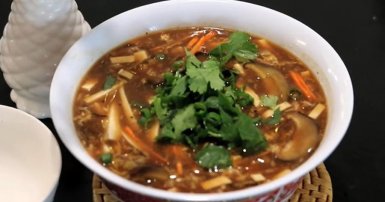
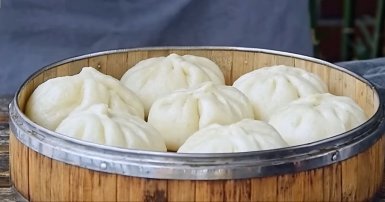
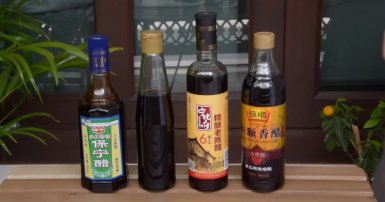
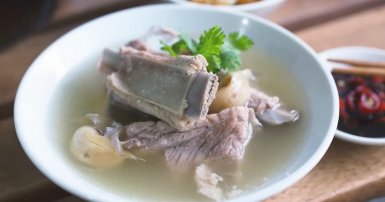


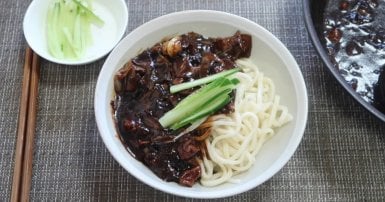


-1709813013.jpg)


